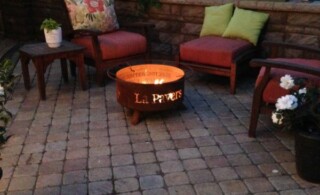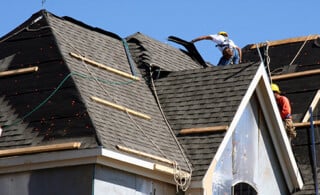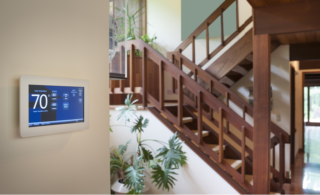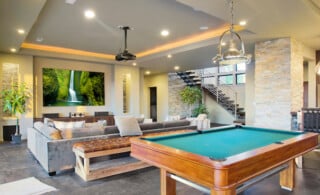
If you’re working on a renovation project, it might be tempting to order pizza and set the kids up with a movie to keep them occupied. But why not let them get in on the action instead?
Depending on their age group, you can involve your children in different aspects of renovation projects, from measuring a space to helping pick out paint colors. Not only will they feel more invested in their home, but they’ll also be learning valuable skills that they can put to use as they get older.
We’ll share activities that can engage and educate your children as they help with a range of age-appropriate projects. They won’t just be having fun—they’ll be learning and helping create a family home at the same time.
Ages 3-5
Children in this age group are improving their fine motor skills like writing, coloring, and cutting paper. They’re learning to count and are hyper-aware of their surroundings. Activities that involve organizing and labeling are good for this age group.
Fine Motor and Counting Activities
These activities can be as simple as having your children help count and identify objects, or you can get creative with items like tongs to help them practice their fine motor skills.
Count Project Supplies
Kids can count out the supplies needed for a project, becoming familiar with their names and uses. We’ve created two worksheets to practice counting. The first prompts kids to count the number of tools they see in each of the six squares, then color in the appropriate number for each. The second allows them to draw the tools used for a project and write how many of each there are on the line.

Sort Objects Into Bins Using Tongs
Organizing things by category can reinforce the concepts of similarities and differences. Set up labeled bins or buckets and give your child a pair of rubber tongs to practice their fine motor skills. Have them use the tongs to pick up each object and place it into its respective bin. This can be done with toys or other project supplies like paintbrushes or fabric scraps.
Cut Paint Swatches and Sort Them by Color
If a local painter is coming to your home, you may be struggling to choose a color. To help, pick up swatches from a paint store and have your family vote on their favorites. Then, have your child cut the strips of various hues into individual squares, mix them up, and group the like colors together or sequence them from light to dark. You can even have them create rainbows from the squares they’ve cut out.
Nature Activities
There’s nothing quite like getting outside with your family and beautifying your yard in the process. These activities can be done with a few supplies you may already have at home.
Create Garden Labels
If you just hired a local landscaper to redo your yard, there are probably lots of new plants to help your child identify. Kids can create garden labels as they learn about each plant. They can even practice color coding for different types of plants—for example; they can use a pink label for flowers, green for trees, and yellow for shrubs.
Dig Holes and Plant Flowers
If you’re refreshing your garden, your children can lend a hand with simple tasks like digging. Get them their own set of plastic gardening tools and teach them how to plant seeds and care for them. When flowers begin to bloom, point out the names and colors of each, and remind your kids that they helped create them by planting seeds.
Ages 6-8
Children in this age group (late kindergarten through early third grade) are continuing to develop their cognitive skills and showing greater independence. These activities will help them practice their reading, writing, and math.
Math Activities
Home projects are all about measuring twice before you make any decisions. Have your kids help with measuring different parts of your house and comparing the size of each room.
Measure Boards
Measuring involves both counting and spatial recognition—two skills children in this age group are learning to master. Children can learn that there are different ways to measure length: the English system of inches, feet, yards, and miles; and the metric system of millimeters, centimeters, meters, etc. The latter can help reinforce base-10 counting as it is applied to projects around the house.
Help Calculate the Square Footage
The concept of square footage will help your children understand how numbers are expressed in spatial terms. How much surface area do they have to work with, and what size rug will fit in the room you’re redecorating? Calculating square footage (the length times the width of an object or an area) is relatively simple and uses multiplication skills children are learning at this age.
Drawing and Counting Tools
This worksheet contains eight boxes, one for each tool. Have your child draw the tools you’re using for a home project. Then, on the line below, have them write how many of each tool you have. For example, if you have two hammers, write “2,” if you have eight screwdrivers, write “8,” and so forth.

Reading and Writing Activities
When completing home projects, there are always instructions to read and lists to write. Use these opportunities to practice reading aloud and spelling skills.
Name That Tool
For this printable exercise, ask your child to write the name of each tool under the appropriate picture. There are eight pictures in all. Go over how to safely use each tool and remind them that these tools can be dangerous so they should always ask for help using them.

Read Project Instructions Aloud
Whether you’re putting together a bed frame or installing a new appliance, you have to read the instructions first. Have your child read the instructions aloud, and then have them help you complete any steps in the process they can do safely. This activity not only enhances their reading skills, but also helps them understand how to interpret and follow directions to achieve a specific goal.
Supply Scavenger Hunt
For this activity, there are two options. If you are working on a home project, send your child on a home scavenger hunt to gather supplies for the project. If you’re not, try a home improvement store scavenger hunt. Make a list of common tools, then go to a home improvement store and find them. You can take silly pictures or split the family up into teams for a more memorable experience. Use this printable checklist to keep track of tools (paintbrush, hammer, pliers, etc.) as you find them. When you’ve found all eight, your scavenger hunt is complete.

Ages 9-11
Children in this age group will learn things like fractions, basic geometry, more complex reading and writing assignments, and introductions to chemistry and biology. They’ll also begin to develop an appreciation for more abstract art forms.
Creative Activities
These practical, yet creative activities will help you and your child refresh a space together. That may be as simple as moving furniture around or hanging up new art.
Create a Floor Plan
You may be looking to remodel a room or reposition your furniture. Kids can help by creating a floor plan on graph paper, marking off one square length on the grid for each foot of space. This can be done for each wall of the room (with the appropriate space left for windows and doors). It’s a great introduction to floor plans and proportional drawing.
Hang Art
Art is an easy and affordable way to transform a space. Let your child pick out art for their room. Allow them to choose where to hang the art and place the nails at the proper spot before hammering. While most art won’t be heavy enough to need a stud finder, this could be a good time to show them how to use that tool.
Make Your Own Cleaning Solution
Children in this age group are learning about chemistry and how different solutions interact in the classroom. They can put this understanding to use (with the help of parents) to create cleaning solutions that are safe for kids and pets in a few simple steps.
Exercises like these help children learn the value of measuring ingredients properly and in the right proportion to create cleaners using what they have on hand. Three-quarters of a cup of water and a quarter cup of rubbing alcohol can combine with a squirt of homemade dish soap and a few drops of essential oil to create an all-purpose cleaning spray.
Communication Skills Activities
Allow your child to be “the boss” by playing a real estate agent or homeowner. It may be fun to film these skits to look back on later.
Give the Family a Home Tour
Another way to build communication skills is by giving a home tour to the family. It gives your child a sense of accomplishment by putting them in a leadership role in which they offer guidance to other family members.
Before the tour, they can fill out our printable brochure with various key pieces of information about your home. It includes the different types of rooms, number of bathrooms, number of rooms overall, and who lives there.

Act Like a Handyperson
If you’re hiring a local handyperson, there are lots of questions you’ll want to ask before choosing the right one. Discuss the project you’d like to hire a handyperson for with your child. Then pretend to be a handyperson and have your child ask you questions and make suggestions for the project. Teach them the importance of asking detailed questions and planning a project thoroughly.
Ages 12-14
Children in this age group are in middle school. They want to feel trusted and express their independence. You can work on more complex projects together and ask them to share their opinion on decorating and decor.
Organization and Communication Skills Activities
There’s nothing you can’t do with a little teamwork. These activities will help you make lasting memories with your child.
Rearrange Bedroom Furniture
Rearranging bedroom furniture is a great idea at this age. It can draw on organizational skills gained in making a floor plan (see above), reinforcing the concepts of measuring, square footage, and planning for furniture and artwork placement.
It’s a great time to do this project because kids are coming into their own at this age and want to express their individuality. This activity is the perfect way to help them feel like they’re getting a fresh start and making their space truly their own.
Plan a Project and Create a Materials List
Planning is an important part of any project, and it’s a skill kids at this age are ready to take the lead on. Decide on a project you’d like to do together like building a terrarium or upcycling a piece of furniture. Draw inspiration from how-to sites or YouTube videos, then set a budget and have your kids make a supplies list. Shop for items together and have your child create a timeline and plan for how to complete the project.
Guess That Tool
If your teen likes riddles, they’ll enjoy this activity. This printable exercise consists of two sheets. One is a series of questions, and the other is the answer sheet. The question sheet consists of eight rhyming clues that you can use to guess what tool is being described. For instance, the first clue is: “With numbers on all my sides, I’m used to measure how long and how wide.” The answer, revealed on the answer sheet, is a tape measure.

Outdoor and Gardening Activities
These activities can be fun for the whole family. Older siblings can lead the projects and get their younger siblings involved.
Regrow Vegetables
Some fruits and veggies can be regrown over and over, including avocados, carrots, celery, onions, and pineapples. All you have to do is keep the base of the plant when you’re chopping it up, then stick it in water or a small amount of soil and watch it grow in your kitchen. Then, when it’s big enough, transfer it to a pot or the ground. It’s a good way to teach teenagers about plant life cycles and concepts such as sustainability.
Invent a Backyard Game
Work with your kids to create an outdoor game you can build together with supplies you have on hand. Examples might include jumbo tic-tac-toe (you can even use pool noodles to set up the grid), wall-mounted ring toss, or an outdoor dartboard set-up.
Ages 15-17
Older adolescents are learning more defined work habits and are better able to explain their choices. Activities that foster independence are important. So are constructive feedback and compliments for your teenager’s achievements.
Design Skills Activities
Small changes can make a big impact. Think of simple ways that will make a space feel more like home, and record the before and after.
Change the Hardware on a Piece of Furniture
Maybe some of the handles on your child’s dresser have fallen off, or maybe they just want to update the look. Plan a project to replace them. Check out options at the hardware store and find a style your teen likes.
Bring the hardware home and go through the steps it takes to update the dresser: drilling new holes as necessary, protecting the inside of the drawer, sanding the appropriate areas, stripping away old paint, and applying new paint or varnish are among the steps you might take.
Decorate a Bathroom
A bathroom decorating project is another job that challenges late-adolescents, gives them a sense of accomplishment, and prepares them for adulthood. They can redecorate a bathroom by hanging new wallpaper, choosing a new paint color, and adding things like candles, decorative art, and rugs, all without demolishing anything. You might consider adding a towel hanger, shower caddy, or medicine cabinet. There are many opportunities to update the look and functionality of this room.
Create a Before-and-After Video Together
You don’t have to stop at the project itself. Why not create a video to document your progress? A before-and-after video can help your child get a greater sense of fulfillment by showing just how much of their work changed the bathroom.
Artistic Activities
As your teen gets older, help them make a space their own with high-impact projects like creating an accent wall or making statement art.
Paint an Accent Wall
Teens and parents can work together to design an accent wall in one of the rooms of their home and paint it together. An accent wall is a wall with a different color, shade, design, texture, or general appearance from those around it. It might be wallpapered, paneled, or painted. This project requires strategy, creativity, and team building.
Create Map Wall Art
You can print out or buy a map of a location where you or your teenager has traveled (on a hike, road trip, boat excursion, etc.). Outline the route it took to get there with ribbon or twine, hot glue it to the map, and then hang it up on the wall. Maps are a great way to teach teenagers about geography. You can even fire their imagination by buying a map of an imaginary place, such as Middle Earth from the “Lord of the Rings” trilogy.
Regardless of your child’s age, there are many activities and projects you can do together. These will reinforce what they’re learning in school, create a great opportunity for bonding and family time, give them a sense of pride and accomplishment, and prepare them for adulthood when they get a place of their own.
 Room By Room Stress Reducers for Your Home
Room By Room Stress Reducers for Your Home  New Home Production is Falling Behind
New Home Production is Falling Behind  How to Choose the Best Smart Thermostat for Your Home
How to Choose the Best Smart Thermostat for Your Home  Why So Many Millennial Homeowners Are Remodeling Their Basements
Why So Many Millennial Homeowners Are Remodeling Their Basements  Leaky Pipes: Water Waste in Your Home
Leaky Pipes: Water Waste in Your Home 

Are You Familiar With This Topic? Share Your Experience.